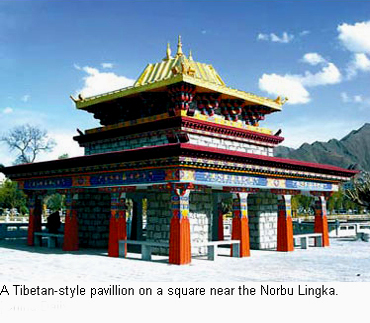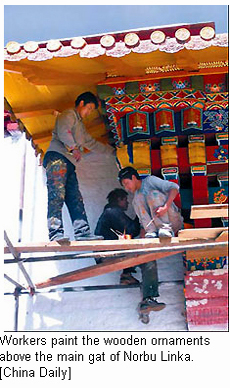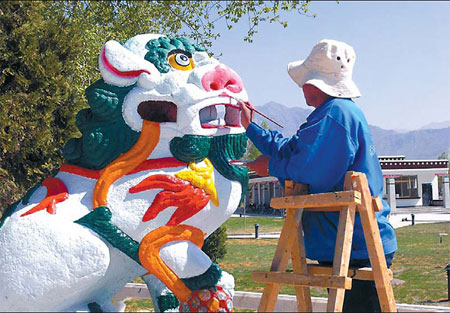In the warm spring sunshine, on a wooden folding ladder, a Tibetan artist is painting bright pink on the nose of a stone lion guarding the main entrance of Norbu Lingka, the previous summer residence of Dalai Lamas.

On the scaffold at the entrance, six younger artists are putting new paint on the fainted color patterns on the wooden ornaments above the main gate.
They are running against time so the popular haunt for both Lhasa residents and tourists is ready to reopen on Thursday.
Not far to the southeast, on a new marble stool, sits 76-year-old Qiangba Gyatso. The Tibetan native of Ledu county, Qinghai province came in early March to visit his two children working in Lhasa.
"This was paved only a month ago," he pointed at the ground. "Lhasa keeps changing. Every time I come, it is different."
This is his third visit to Lhasa.
"Lhasa is getting prettier all the time. Look at the landscaping," he nodded at the sprawling new garden outside Norbu Lingka. In the distance, gardeners are watering new lawns in front of a newly built Tibetan-style pavilion, whose golden roof gleams against the azure sky.

Besides circumambulating local monasteries, Qiangba Gyatso enjoys basking in Lhasa's warm sunshine in the morning. Norbu Lingka is his new favorite.
Sources with the Tibet autonomous region's development and reform commission (DRC) said the renovation project costs 87 million yuan ($12.4 million). This is part of a latest renovation and preservation package for the region's major buildings of cultural significance, including the Potala Palace and Sakia monastery.
This is impressive for Tibet, where, in the words of Qiangba Puncog, chairman of the regional government, nine out of every 10 yuan spent by the local government are from transfer payment by the central government.
"Tibet would not have been what it is, were it not for the persistent favor from the State coffers and the variety of aid programs sponsored by fraternal provinces and municipalities," says Yangchen Dolkar, a deputy section chief with the regional DRC.
Tibet's per capita gross domestic product exceeded 12,000 yuan in 2007, almost doubling its 2002 figure, and the region's economy has, for seven consecutive years, maintained an annual growth of more than 12 percent.
That, according to Yangchen Dolkar, has much to do with outside assistance.
The four central government conferences on development issues in Tibet, in 1980, 1984, 1994 and 2001, have proved instrumental in materializing the dramatic changes in the region's economic landscape.
The 1994 meeting's idea to have other provinces, municipalities, central government offices, and major State-owned firms to team up with and assist localities in Tibet deserves particular credit for Tibet's current prosperity, says Zhang Jianjun, deputy chief of Tibet's office of one-on-one aid programs.
All the rest of the country has been involved in the high-profile aid-Tibet program.

A Tibetan aritst paints the nose of a stone lion at the main entrance of Norbu Lingka, the former summer residence of Dalai Lamas.
"By the end of June 2007, domestic aid providers had financed 9.3 billion yuan on 2,861 major projects in Tibet," Zhang disclosed. "And ordinary Tibetans have witnessed tangible improvements in their lives."
Farmers' and herdsmen's per capita net income reached 2,788 yuan in 2007, 83.3 per cent up from 2002, according to Yangchen Dolkar, and 114,000 households saw improvements in housing conditions.
Tsomo's is one of them.
"We used to live in a dark and shabby flat in Xoi," says Tosmo. "We moved into a new and bigger flat in the New Xoi neighborhood in 1996."
Xoi is a centuries-old residential community at the foot of the Potala whose residents were mostly people serving the high lamas and nobles.
The New Xoi community, located not far to the northwest of the Potala Palace, features Tibetan-style buildings with modern power and flushing systems.
"Now we have an independent kitchen and a private restroom," she says with obvious content.
The 51-million-yuan new community, in addition to providing all the basic conveniences of modern urban homes and neighborhood services, includes a kindergarten and a primary school.
"If the first aid packages included more big infrastructure projects to fill blanks in basic facilities, the recent ones are increasingly titled toward upgrading qualities of life," says Yangchen Dolkar.
The autonomous region has spent 6.16 billion yuan on social undertakings since the 10th Five-Year-Plan period, more than 91 percent of which came from central finance.
Since the 10th Five-Year-Plan period, the region spent almost 3.4 billion yuan to have 2.2 million square meters of classroom space built or renovated. Across Tibet, schools often boast the best buildings in their communities.
"More than 80 percent of the new projects planned for the 11th five-year-plan period aim directly at improving living conditions, including building rural power grids, providing access to safe drinking water, and garbage and sewage treatment," says Yangchen Dolkar.
The central government has earmarked 77.8 billion yuan for 180 projects between 2006 and 2010 to improve infrastructures as well as farmers' and herdsmen's living conditions, she said.
"The kids in agricultural and pastoral areas enjoy free food and lodging and are exempted from any school fees," says Yangchen Dolkar. "Which is unthinkable in the rest of the country.
"Farmers and herdsmen in Tibet enjoy free medical care. And agricultural tax, which had not been abolished in the rest of the country until last year, has never been collected here. How much more favors can we expect from the central government?
"Every bit of change in Lhasa and elsewhere brings additional comfort and convenience to our life. And we enjoy it."
(China Daily April 29, 2008)